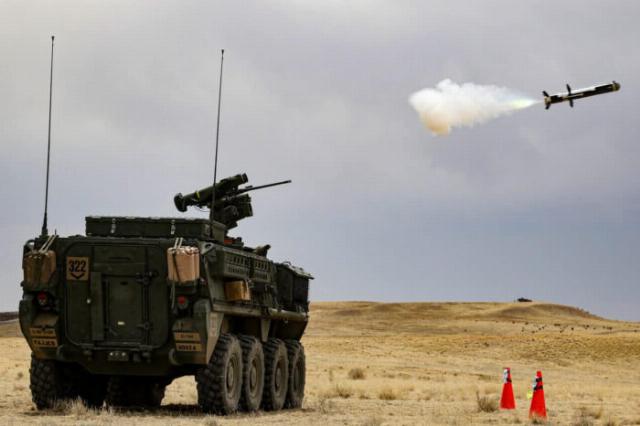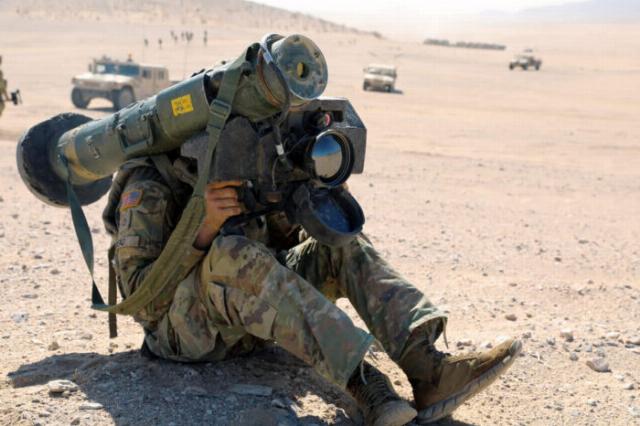Global market surveys predict continued high demand for anti-tank guided missiles (ATGMs) over the next decade.
Despite the fact that the likelihood of low-intensity conflicts has not gone away, according to foreign military experts, the world is experiencing a return to great power clashes and interstate wars. In this regard, it is believed that the prospect of fighting with the participation of armored formations is growing – therefore, the national armed forces need to strengthen their capabilities to defeat main battle tanks (MBT) and other heavy or medium armored vehicles.
The ongoing war in Ukraine is a prime example of new conflicts. Citing open sources, the Dutch website Oryx claims that Ukraine and Russia lost hundreds of tanks in the first year of the war alone. The statistics provided include losses from enemy tank and artillery fire, rocket-propelled grenades (RPGs), unmanned aerial vehicles (UAVs), barrage ammunition and mines. Nevertheless, a significant part of the destroyed tanks were neutralized by anti-tank guided missiles (ATGMs), which underlines their importance as part of a holistic strategy to combat armored vehicles.

A shot of the Javelin ATGM from the CROWS armory station of the Stryker armored personnel carrier, April 2022.
Although various ATGM market analyses differ on specific figures, studies such as the Insight Partners report (2020-2031), the Technavio report (2022-2027), the Research and Markets report (2023-2024) and the IMARC Group analysis (2024-2032) agree that demand growth will remain high in all major regions of the world. Projected cumulative annual growth rates (CAGR) range from 3.1% to 4.7% over the respective study periods. Again, with minor deviations, studies suggest that the cost of anti-tank missile systems (ATGMs) on the world market in 2023 will be approximately 3 billion US dollars.
Technavio estimates that this market segment will increase by $472.45 million by 2027, while IMARC Group analysis predicts that global sales will reach $4.2 billion by 2032. North America remains the largest regional market, followed by Europe and the Asia-Pacific region in approximately equal shares. The main factors here are the increased perception of the threat from Russia, China and North Korea, to which the United States, NATO Europe, South Korea and Japan are responding. In the case of the United States and Europe, the need to replenish stocks transferred to Ukraine will be decisive, which will force short- and medium-term investments in excess of previously planned acquisitions.
Characteristics of the ATGM
Anti-tank guided missiles have a number of advantages, including flexibility, accuracy and mobility. This is a relatively inexpensive weapon that allows you to purchase large stocks to defeat very expensive MBT and other armored vehicles. Their small size and ease of handling make it possible to fire from cover. They can also be used by dismounted infantry (from the shoulder or on tripods) or mounted on a wide range of platforms – from light vehicles to MBT. Helicopters, attack UAVs and manned or unmanned boats can also carry them, maximizing potential attack directions.
Although they are primarily designed to defeat MBT and other armored combat vehicles, they can also be used against bunkers and other fortified targets, against poorly protected targets such as ground-based fuel and ammunition depots or parked aircraft, and even against low-flying helicopters.
Compared to RPGs, ATGMs have a longer firing range and the ability to maneuver in flight. Moreover, some of them are able to follow an inclined trajectory to strike from top to bottom on the weaker roof armor, which can be seen on most armored platforms.
Guidance and targeting systems typically use either a homing system, usually an infrared (IR) homing head (homing), or a semi-automatic line-of-sight guidance system (SACLOS), such as laser beam control or wired guidance (fiber optic).
A large percentage of modern ATGMs are "shot–and-forget" type weapons, which allow crews to leave the position immediately after the attack begins. It is relatively easy to train personnel to handle them. At the same time, SACLOS-type anti-tank guided missiles require that the shooter, whose location has been disclosed, remain in position until hitting the target. In this case, the shooter (or the combat platform) remains vulnerable to a counterattack. On the other hand, wire-guided and laser-guided missiles are often immune to many forms of electronic interference or blinding, and are difficult to confuse with cloaking devices.
The range of fire varies widely, while most ATGMs reliably destroy targets located at a distance of about 3-8 km; and versions with an increased range of fire out of line of sight (NLOS) allow firing at distances up to 30 km or even more. As for combat units (warheads), most ATGMs are equipped with either a unitary cumulative anti-tank (HEAT) charge or a tandem cumulative charge.
Modern anti-tank guided missiles
ATGMs are being developed and manufactured in many countries. Numerous projects are ongoing to develop new, technologically advanced weapons – or modernize old systems. However, some surprisingly old designs continue to work at the highest level.
FGM-148 Javelin ATGM
FGM-148 Javelin anti-tank missile (Javelin / Spear) It entered service with the US Armed Forces in 1996 and has been constantly upgraded since then. It is currently in service with 24 countries, including Ukraine, which, according to its own statements, produced up to 500 Javelins daily in the early stages of the war.
According to the US Army , the Javelin shot–and-forget missile is designed to destroy all known and promising types of armored vehicles. The missile uses a direct attack profile or a top-down attack. The firing range is up to 4 km.
It uses an on-board infrared GPS and a tandem cumulative warhead. The soft-launch system ejects the munition from the missile silo and starts the main engine as soon as the projectile is at a safe distance from the operator, which protects personnel from possible injuries. Detection, identification and target selection are carried out using a removable command and launch unit (PBC) using daytime and IR channels with different magnification levels. Guidance data is sent to the missile guidance system through the interface of the launch tube assembly, and the missile is launched.

A US Army soldier uses the Javelin PBC to find a target
FGM-148 Javeldine is produced by the Javelin joint venture created by Lockheed Martin and RTX. Current updates include:
- lightweight PBC (LWCLU) with smaller dimensions and increased battery life (first deliveries are expected in 2025);
- multi-purpose warhead (MPWH), which retains full armor penetration, but adds a fragmented steel body to increase the effectiveness of hitting personnel and light equipment (entered production in 2020 under the name FGM-148F);
- The FGM-148G warhead, which will have a new launch tube assembly, battery and guidance unit.
The decision to manufacture the FGM-148G was postponed due to software problems. In the absence of further complications, the army expects to field the first units in fiscal year 2025. Regardless of the development of the ‘G’ model, the Javelin joint venture is currently aiming to increase annual production from 2,100 missiles in 2022 to a target of 3,960 units. by the end of 2026.
Apart from these developments, Javelin goes beyond a purely portable system. So, since 2021, the rocket has been successfully launched from the JLTV light tactical vehicle, the 8×8 Stryker armored personnel carrier and various uninhabited platforms.
ATGM-71 TOW ATGM
The TOW / Tube-launched, Optically-sighted, Wire-guided anti-tank missile BGM-71 ( TOW/ Tube-launched, Optically-sighted, Wire-guided) entered service in 1970. Originally developed by Hughes Aerospace, RTX is now being produced. To date, more than 700 thousand units have been delivered, which are equipped with the armed forces of more than 40 countries.
Since SACLOS-type wired guidance systems require a stable weapon control platform, the BGM-71 is usually mounted on a tripod or launched from a vehicle or helicopter. Fasteners for vehicles can consist of a single support, two-pipe or four-pipe configuration. Moreover, the crew can use ammunition while behind the armor.
BGM-71F TOW 2B Aero ATGM Shot with HMMWV
Modern options include:
- The BGM-71E missile (also known as TOW 2A) with a firing range of 3750 m and a tandem cumulative warhead with penetration up to 1000 mm of homogeneous rolled steel armor (RHAe);
- The BGM-71F (TOW 2B Aero) missile with a firing range of 3,750 m and two tantalum explosive penetrating cores (EFP);
- missiles in the RF variant (TOW 2A RF and TOW 2B RF).
The latest version of the missile uses an overhead attack profile (OTA) for which it flies over the target. When the dual-mode Thales sensor detects a target, it activates both cores simultaneously. To increase the chances of successful penetration, one shoots vertically down, and the other at a slight angle.
RF variants of both (TOW 2A RF and TOW 2B RF) replace wired control with one-way radio frequency communication, but still require the operator to actively aim the missile at the target. In the case of the TOW 2B RF variant, the missile's firing range is increased to 4,500 m.
To be continued…
Based on the materials of the resource euro-sd.com

